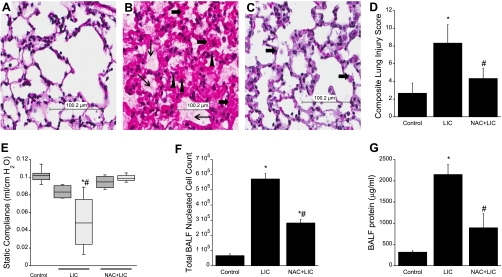Fig. 1.
N-acetyl-cysteine (NAC)-mediated protection of lung injury. n = 3 Mice per group. Hematoxylin-eosin (H&E)-stained, formalin-fixed, paraffin-embedded lung tissues are from mice subjected to spontaneous breathing with normoxia (control; A); preexposure to hyperoxia followed by high tidal volume (Vt) mechanical ventilation (HV) with hyperoxia (HO) [lung injury conditions (LIC); B]; or NAC pretreatment followed by LIC (NAC + LIC; C) (scale 100 μM). LIC shows evidence of extensive lung injury with interstitial and alveolar edema (thin arrows), hemorrhage (▲), and acute inflammatory cell infiltration (thick arrows), whereas NAC protected mice subjected to LIC. D: composite lung injury scores (LIS) represent the sum of the mean injury subtype scores for each condition on a scale of 0–16. The LIS were significantly higher in animals exposed to LIC, whereas NAC treatment significantly reduced LIS. E: box plot of quasi-static compliance (QSC) of the three experimental conditions at time 0 and at the end of the experiment. Dark gray bars indicate time = 0 (immediately before starting mechanical ventilation); light gray bars indicate time = 4 h (immediately after end of mechanical ventilation). Horizontal lines indicate median, shaded boxes indicate inner quartile, and whiskers indicate data range. The QSC was decreased in LIC, compatible with observed increased lung injury, whereas NAC treatment prevented this decrease in QSC. Total bronchoalveolar lavage fluid (BALF) cells (F) and BALF protein concentration (G) were significantly high in LIC. NAC + LIC decreased both BALF total cell counts and also protein concentration. Values are means ± SD. *P < 0.05 compared with control. #P < 0.05 compared with LIC.

